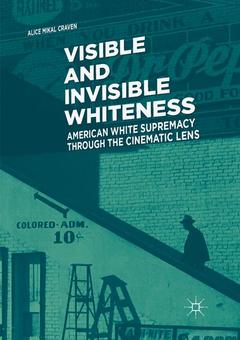Visible and Invisible Whiteness, 1st ed. 2018 American White Supremacy through the Cinematic Lens
Auteur : Craven Alice Mikal

Visible and Invisible Whiteness examines the complicity between Classical Hollywood narratives or genres and representations of white supremacy in the cinema. Close readings of D.W. Griffith?s The Birth of a Nation by James Agee and James Baldwin explore these authors? perspectives on the American mythologies which ground Griffith?s film. The intersectionality of Bordwell?s theories on Classical Hollywood Narrative versus Art Cinema and Richard Dyer?s seminal work on whiteness forms the theoretical base for the book. Featured films are those which have been undervalued or banned due to their hybrid natures with respect to Hollywood and Art Cinema techniques, such as Samuel Fuller?s White Dog and Jean Renoir?s The Southerner. The book offers comparative analyses of American studio-based directors as well as European and European émigrés directors. It appeals to scholars of Film Theory, African American and Whiteness Studies. It provides insight for readers concerned about the re-emergence of white supremacist tensions in contemporary America.
Alice Mikal Craven is Associate Professor of Comparative Literature and Chair of Film Studies at The American University of Paris, France. In addition to publications on selected authors and filmmakers featured in this volume, she is co-editor of Richard Wright: New Readings in the 21st Century (Palgrave 2011) and Richard Wright in a Post-Racial Imaginary (2014), which received a 2015 Outstanding Academic Title award from Choice magazine. She has been invited to give public interventions in Paris on films such as Selma and Dear White People, and on the Black American expatriate community’s perspective on the Franco-Algerian war.
Date de parution : 01-2019
Ouvrage de 220 p.
14.8x21 cm
Disponible chez l'éditeur (délai d'approvisionnement : 15 jours).
Prix indicatif 94,94 €
Ajouter au panierDate de parution : 06-2018
Ouvrage de 220 p.
14.8x21 cm
